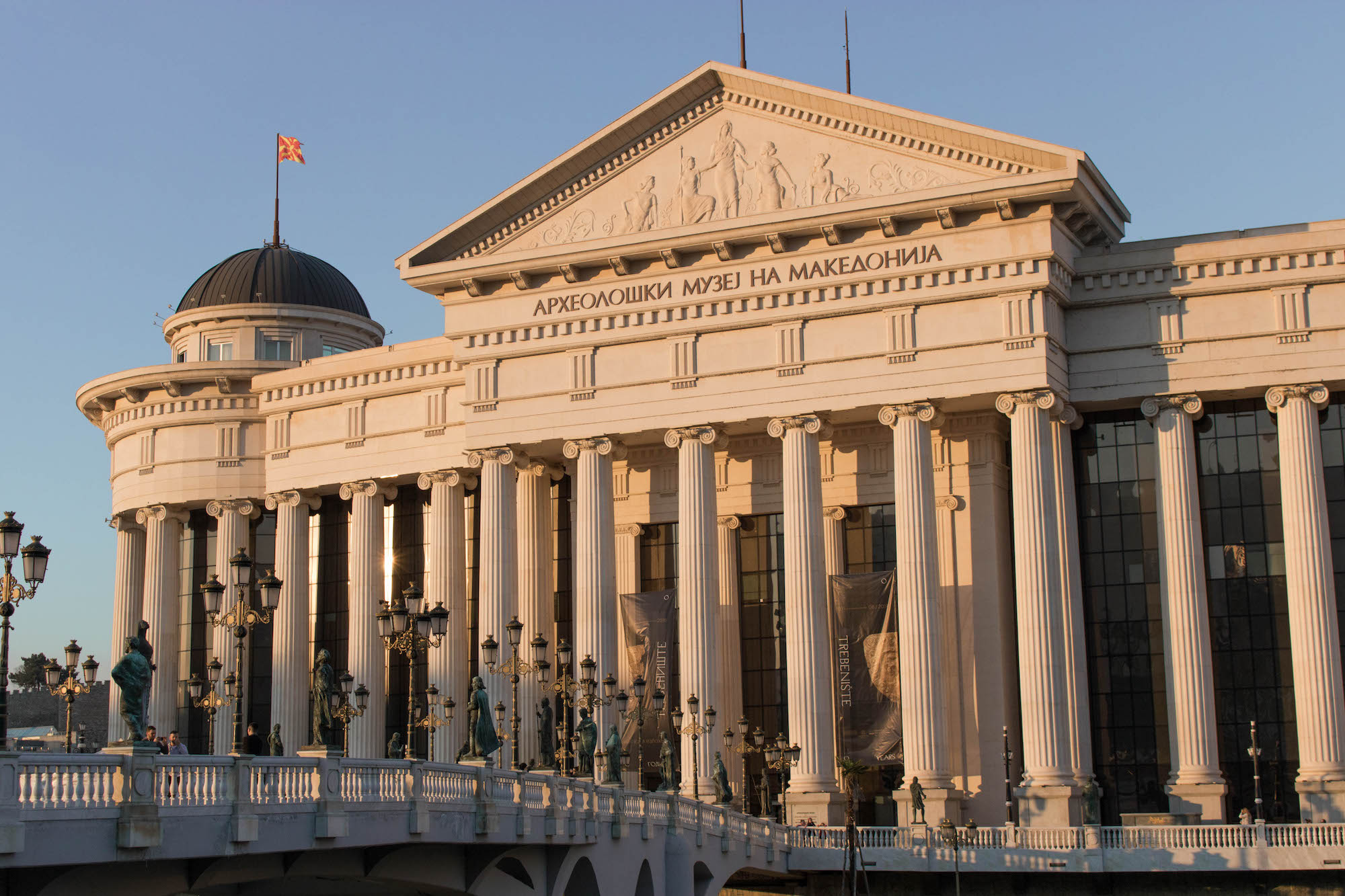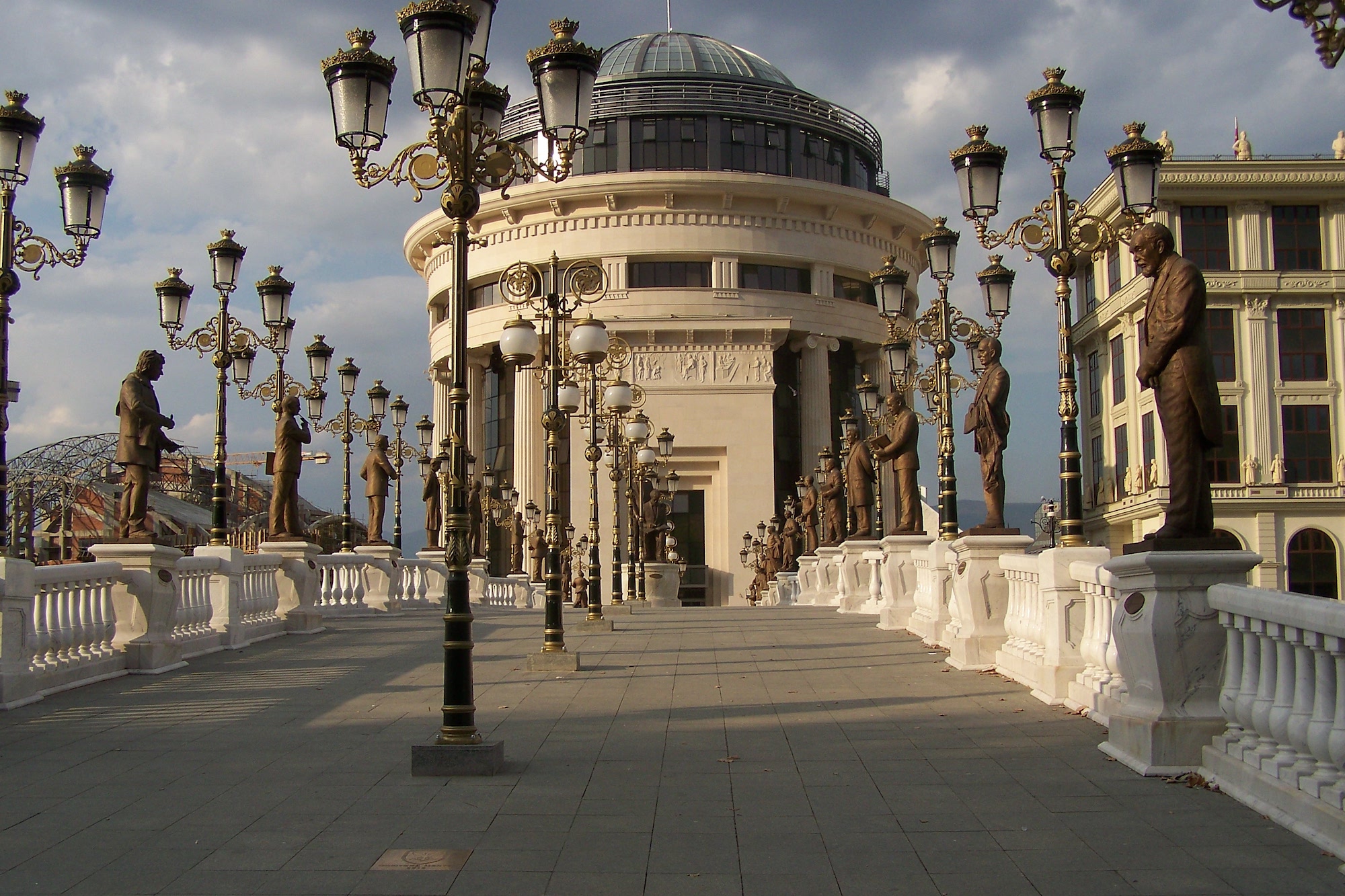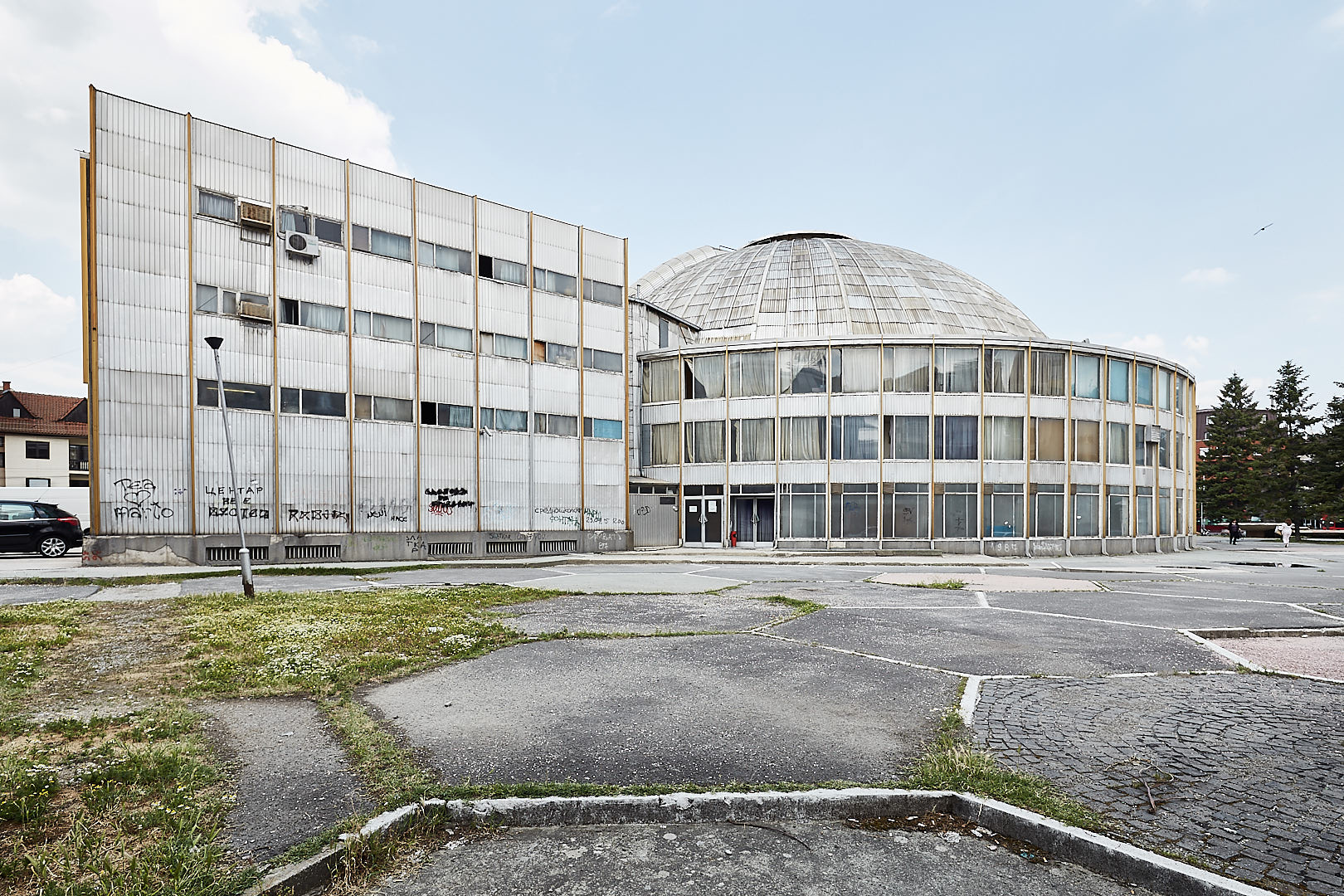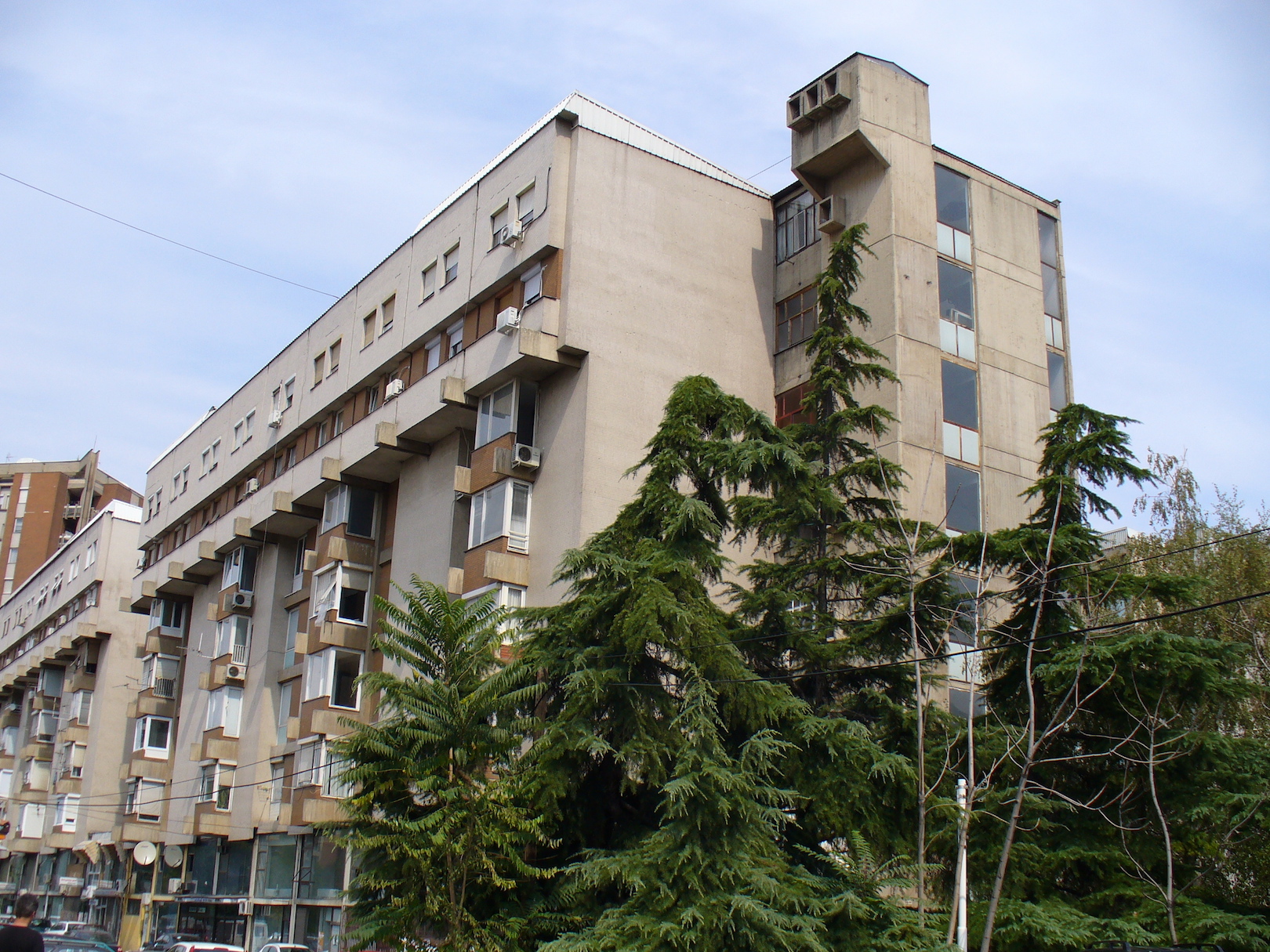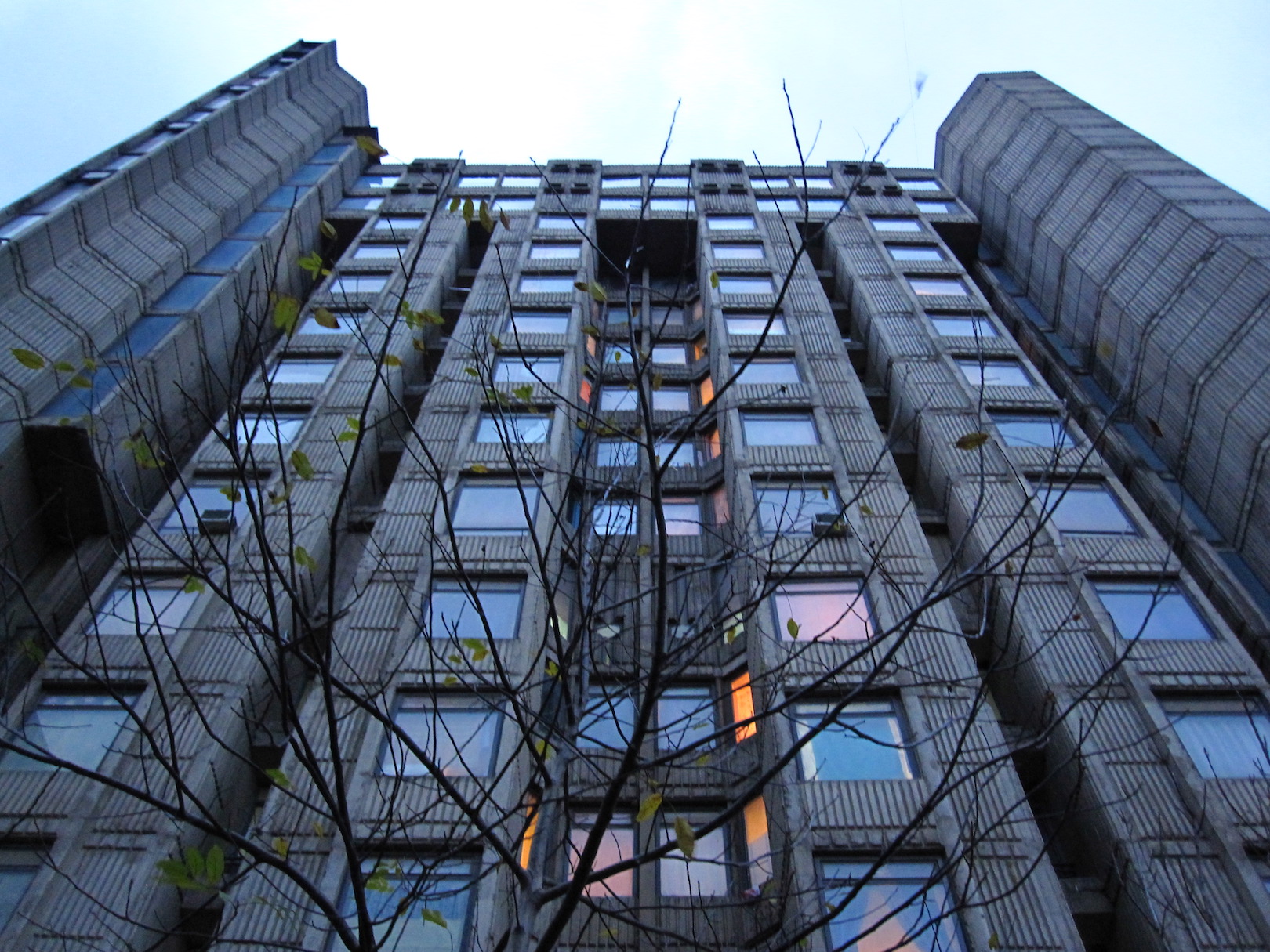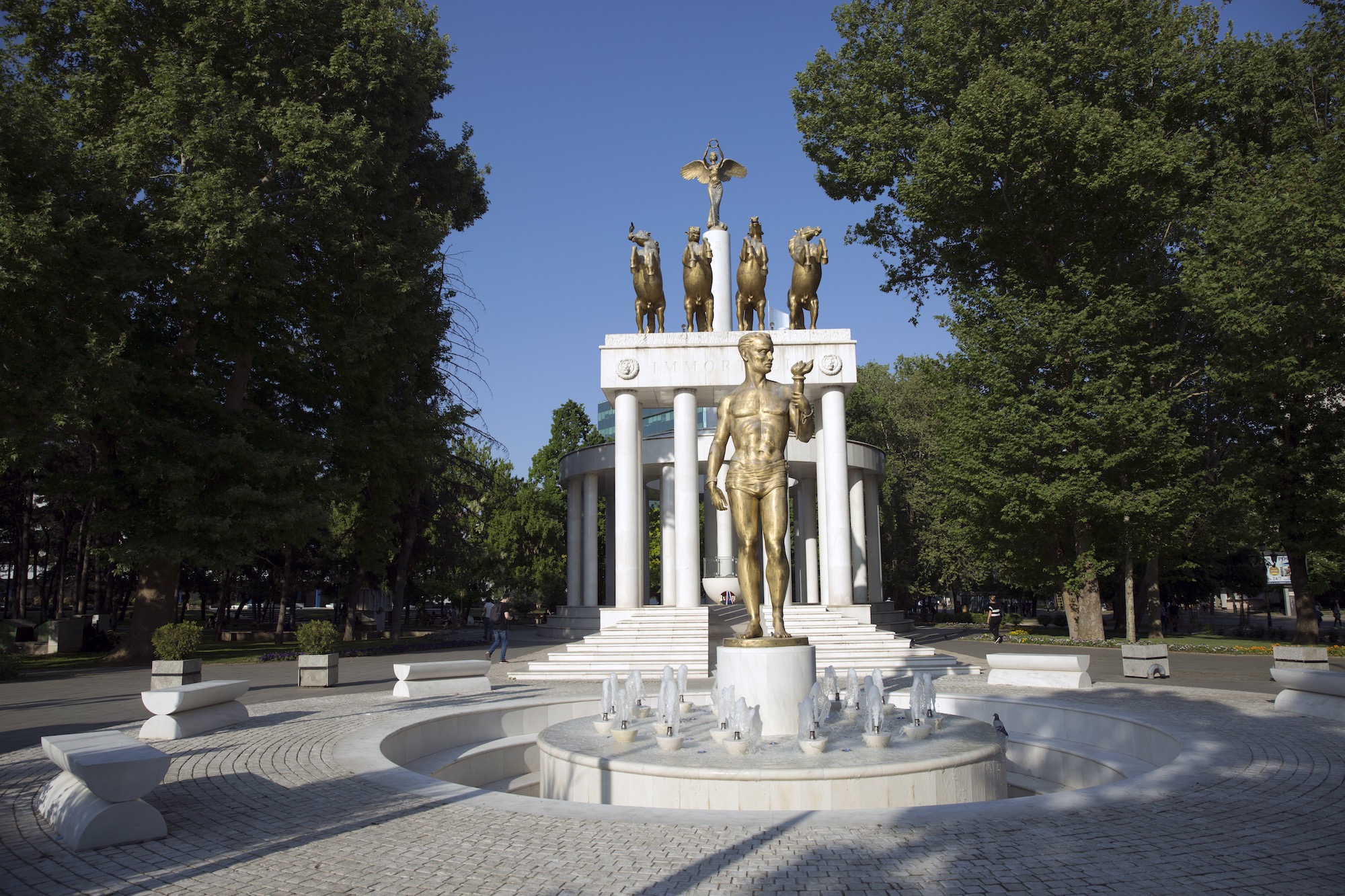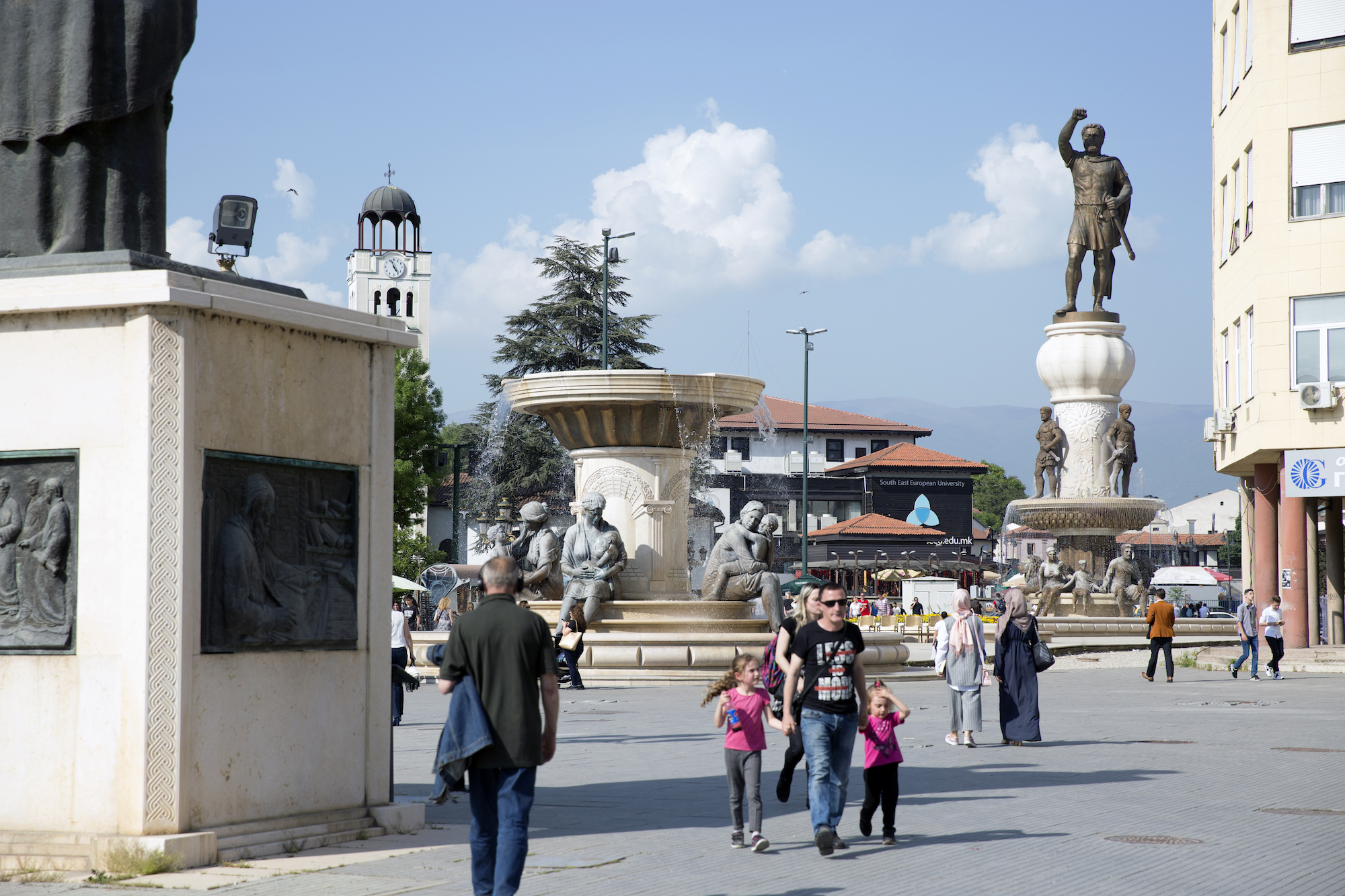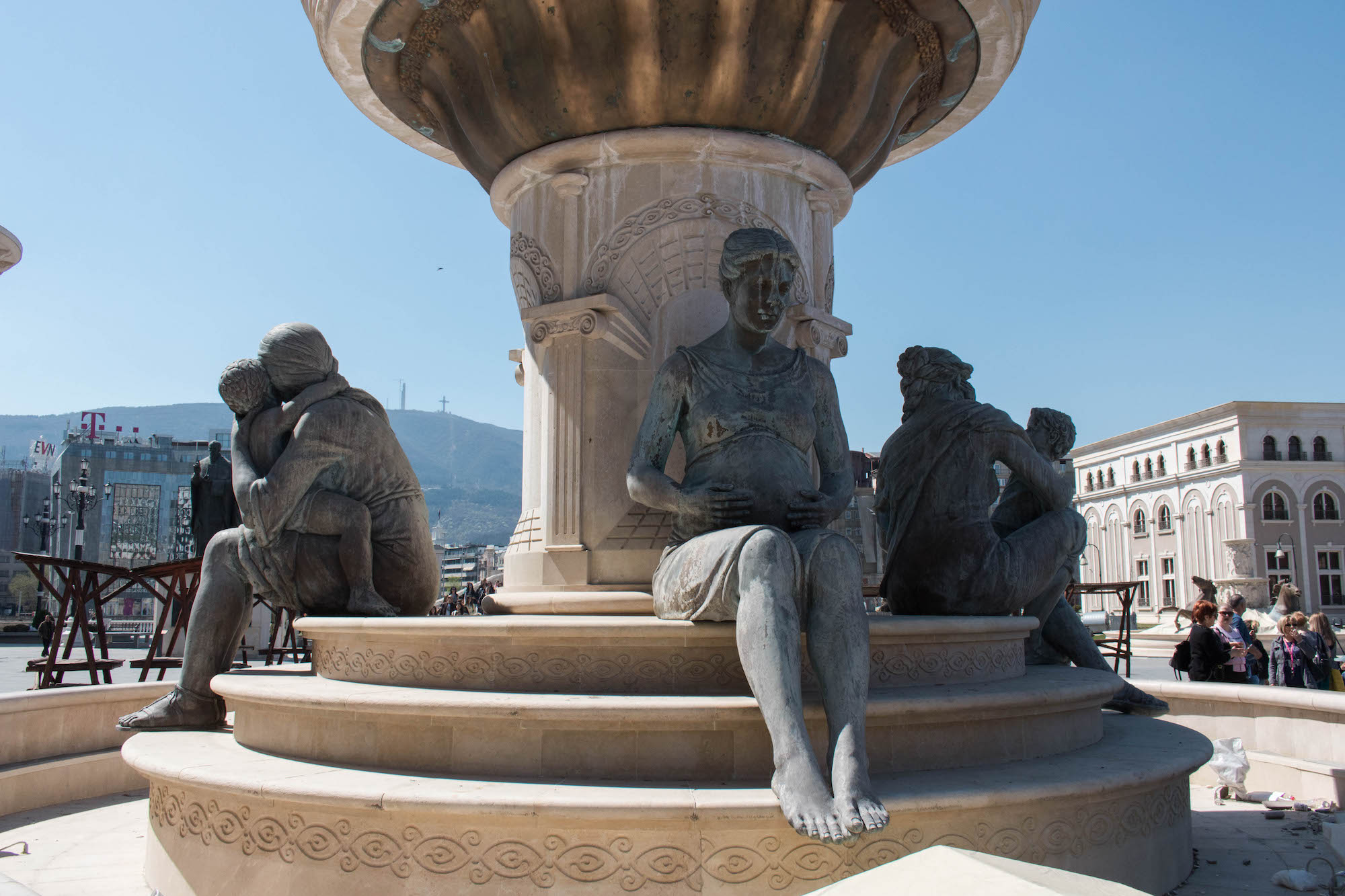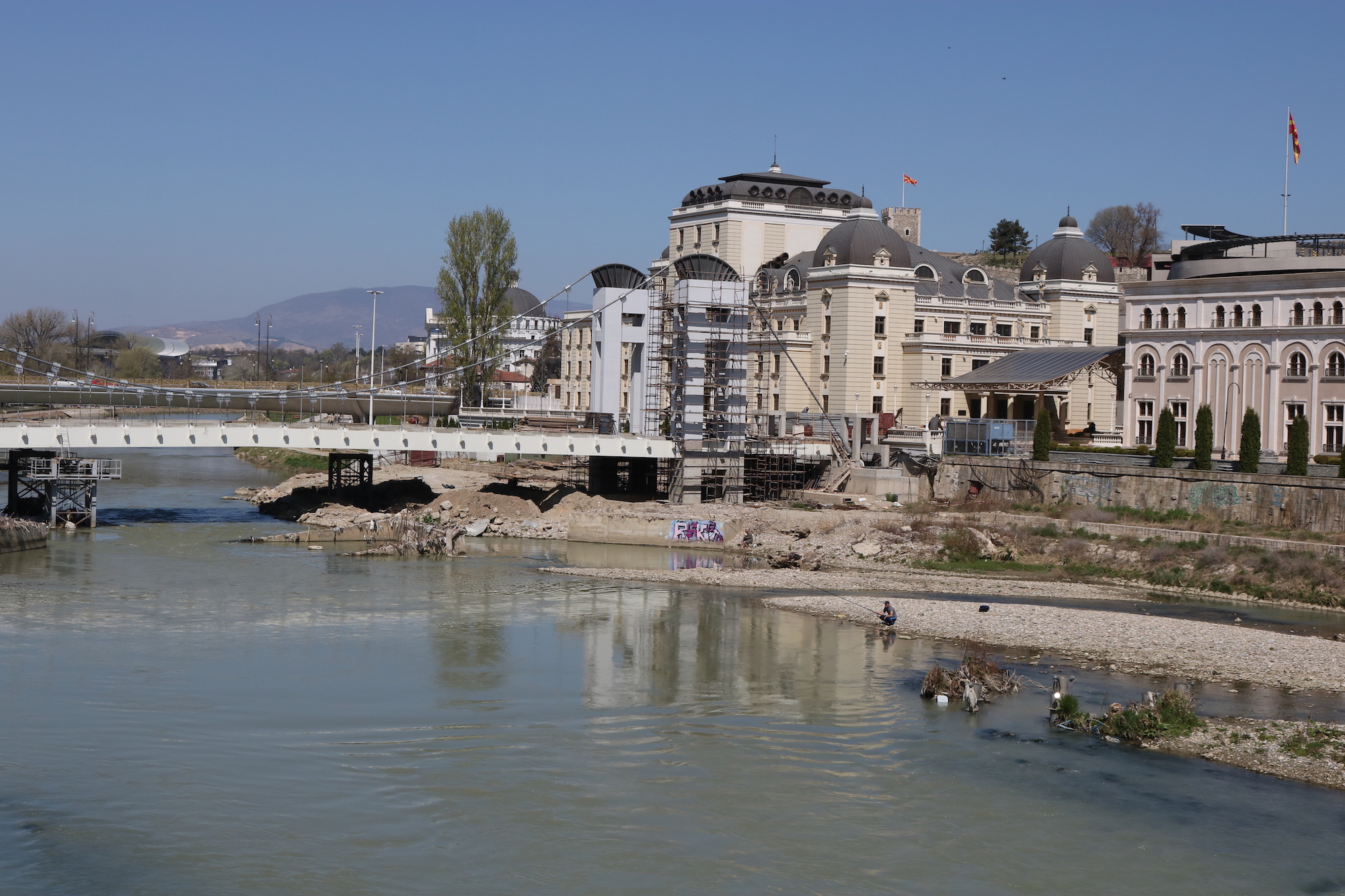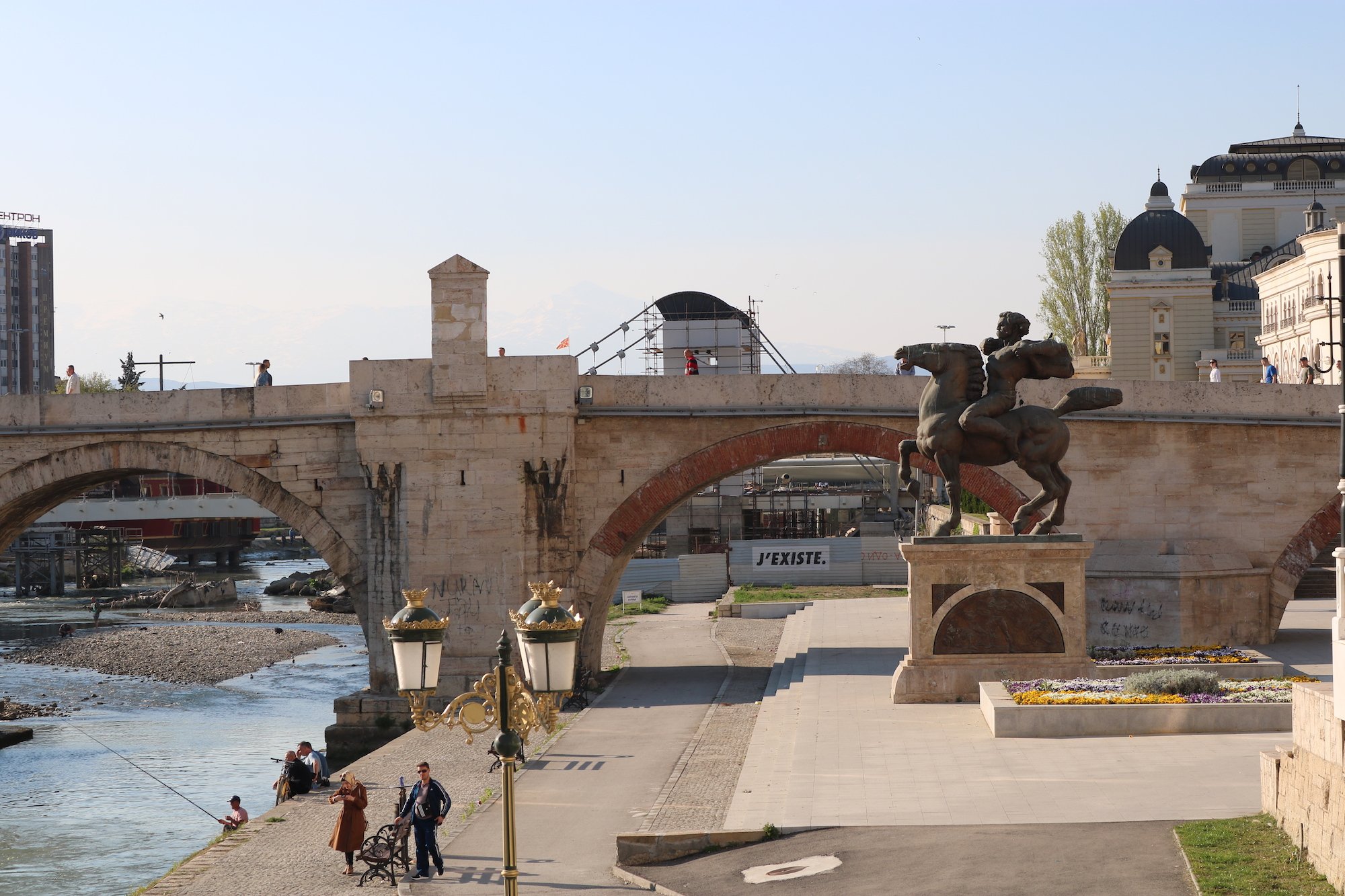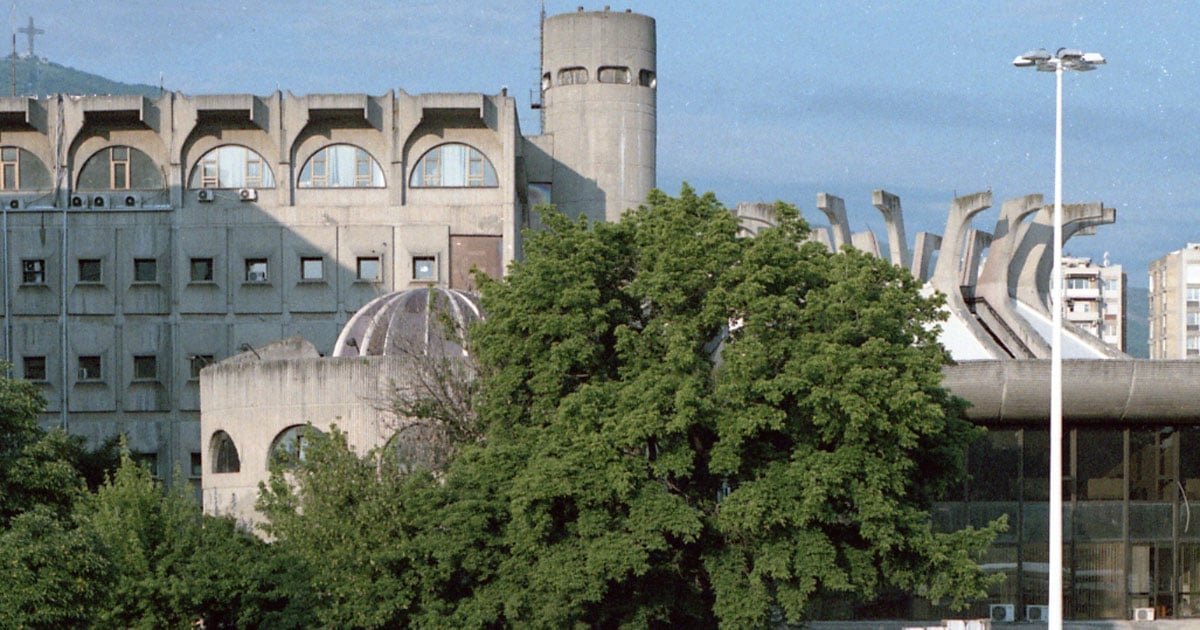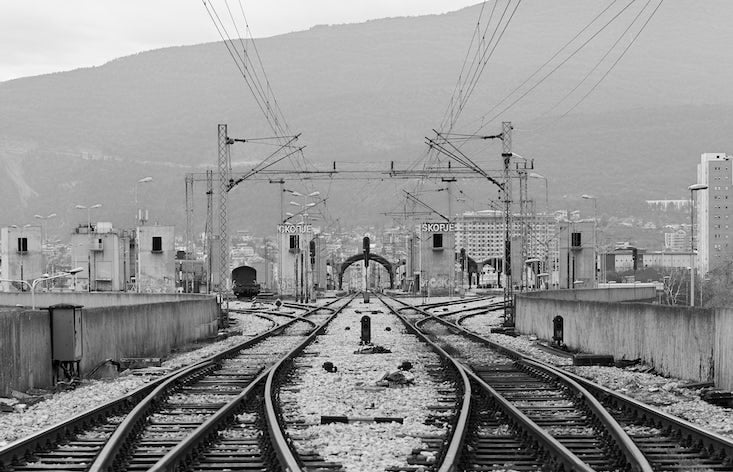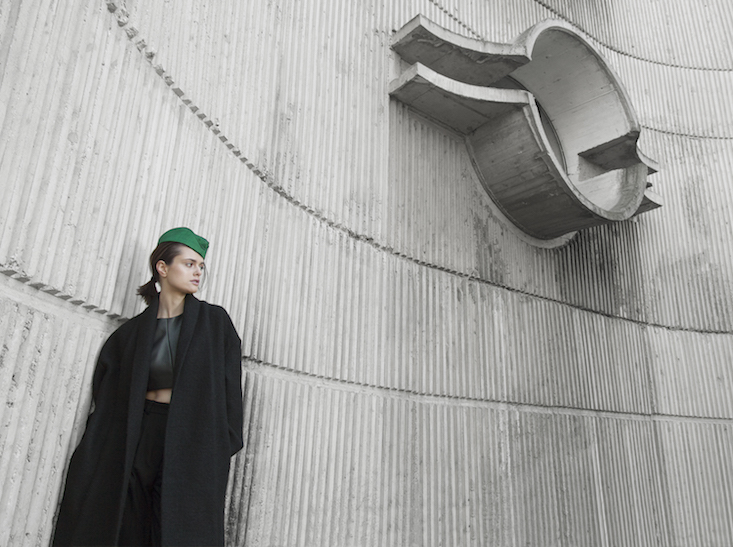After overthrowing its government and changing its name, North Macedonia faces up to the urban crisis in Skopje
The pet project of deposed former Prime Minister Nikola Gruevski, the urban remodelling known as ‘Skopje 2014’ saw the North Macedonian capital transformed by a wave of kitsch Neoclassical add-ons. As the newly-renamed nation moves on from its autocratic former ruler, what next for this bewildered and bewildering city?
Visitors to Skopje’s central Macedonia Square are confronted by a 25-metre bronze equestrian statue, titled “Warrior on a Horse”. This supposedly anonymous figure is widely understood to represent the ancient hero Alexander the Great on his steed Bucephalus; soon this will become official. A new commemorative plaque will explain that Alexander was a figure from Hellenic antiquity, and thus a part of world cultural heritage. Indeed, future visitors to the square will encounter a renamed landmark in a renamed country: The Republic of North Macedonia, as the nation is now known.
The country’s name change was officially introduced on 12 February. It is part of the “Prespa Agreement”, which puts an end to an almost quarter-century-long dispute between (now-North) Macedonia and Greece surrounding claims to the cultural legacy of the ancient Kingdom of Macedonia. Prespa settles the conflict by awarding Greece exclusive use of the name “Macedonia” for its northernmost region, and sole claim to that area’s ancient heritage; in turn, the Agreement paves the way for North Macedonia’s entry into NATO and the European Union. The soon-to-be Alexander statue is thus a sign of the foreign policy successes of the current North Macedonian government. It is also indicative of its most pressing domestic failures.
The monument was part of the controversial, wide-ranging urban revamp scheme known as “Skopje 2014”, which aimed to glorify a dubious version of Macedonian national history and cultural heritage dating back to Antiquity. The driving force behind the scheme was former Prime Minister Nikola Gruevski, who sought political asylum in Hungary in 2018 following a conviction for abuse of public office. His nationalist conservative party, VMRO-DPMNE, seized power in 2006 before being forced out of office in 2016 after massive anti-government protests against its authoritarianism.
“Warrior on a Horse”, aka Alexander the Great. Image: Liza Premiyak
A legacy of the deposed Gruevski government, Skopje 2014 was mostly enacted between 2010 and 2017. Besides the statue of Alexander, it involved the construction of dozens of Neoclassical governmental and cultural buildings, the erection of about 40 monuments to national heroes, various public artworks, the insertion of new bridges and squares decorated with yet more statues, the Baroque and Neoclassical reconstructions of façades, and more. This large-scale urban reconstruction embraced the idea of a long and uninterrupted Macedonian narrative, stretching from Antiquity to the creation of an independent modern state, via the Slavic and medieval periods and the national struggle against Ottoman rule.
Skopje 2014 was an undemocratic, opaque, top-down, and nepotistic undertaking. Regarded as representative of Gruevski’s autocratic regime, many Skopje 2014 constructions were regularly shot with paintballs during the 2016 anti-government protests that ousted the VMRO-DPMNE — hence the nickname “the Colourful Revolution”.
Skopje 2014 was an undemocratic, opaque, top-down, and nepotistic undertaking. It was also an assault of Skopje’s architectural heritage
It was also an assault of Skopje’s architectural heritage. The Gruevski government’s quest for an urban form that would fit its nationalist paradigm resulted in a recapitulation of 19th-century European monumental architecture. By materialising this concept of Macedonian history — partly in stone and bronze, partly in concrete and Styrofoam — Skopje 2014 introduced radical changes to the built environment, in a style out of keeping with the country’s socialist past.
Skopje’s urban design, after all, was already unique. In 1963, the city was devastated by an earthquake. In response to an appeal from Yugoslav leader Josip Broz Tito, a remarkable amount of financial and technical aid soon poured into the country. Yugoslavia being a non-aligned country, United Nations recognised an opportunity to stage a display of international unity via the reconstruction effort. The 1965 urban design and redevelopment plan, conceived by an international team of architects led by Japanese master Kenzō Tange, was one of the grandest attempts ever made to embody progressive socialist and Modernist urban ideals.
View on central Skopje through two socialist-era housing blocks. Image: Vase Amanito/amanito.mk
For many residents, Skopje’s formerly Modernist identity was a source of pride, now annihilated. They have compared the psychological effects of the urban renewal to those felt following the devastation of the ‘63 earthquake. “This is just not Skopje,” Jana, a visual artist told me (the names of interviewees have ben changed). “I sometimes say that we may sound like the old Skopjeans — those who suffered after [losing] pre-earthquake Skopje. They will never see Skopje as they knew it from their childhood or adulthood. I think my generation is going to go through the same. We will suffer for the Skopje that wasn’t beautiful but was ours. It was an interesting mix of modern architecture and older buildings. That was my Skopje.”
Tange’s plan for Skopje was based on the principles of a medieval city: it envisioned a “city wall” of residential buildings encircling a “city core”, and a “city gate” — a kind of access point incorporating different transportation networks. It was a radical vision that ultimately remained unrealised: the plan underwent many alterations, while the economic decline of Yugoslavia in the 1980s put a stop to much of the intended construction. Despite this, the Modernist spirit of renewal behind the plan was pivotal for the creation of the city’s new identity, providing some of post-earthquake Skopje’s most prominent buildings — the Goce Delčev Student Complex, the Central Skopje Post Office, the University Campus, the Museum of Macedonia, the Government House, and the City Trade Centre.
Given this all-too-recent history, the faux-Neoclassical facelift of Skopje is even more destructive. Indeed, Skopje 2014 has provoked immense criticism for its dubious architectural aesthetics, said to have turned the city into a theme park, or a mini Vegas. Both experts and the public have argued that Skopje 2014 not only represents the degradation of the city’s Modernist architectural identity, but also an extremely hazardous intervention into Skopje’s urban system and public spaces.
A key electoral pledge of the Social Democratic Union (SDSM) that replaced the VMRO-DPMNE was a moratorium on Skopje 2014 projects. A ban on any further construction activity in the central area of Skopje was indeed imposed by the Municipality Centre of Skopje in 2017. Yet this act has proved insufficient when it comes to resolving the urban misfortune visited on the capital by its recent makeover. The North Macedonian government is now expected to fulfil its election promise and finally make decisions concerning the future of Skopje 2014. But while many experts and politicians agree that something must be done about this urban atrocity, what direction this “reconstruction of the reconstruction” should take remains unclear.
In contrast to the Gruevski government, current officials have at least decided to consult experts on the issue. In July 2017, the Ministry of Culture, which is the investor behind almost 20 per cent of the Skopje 2014 works, formed a six-member working group comprised of experts from the fields of architecture, political science, art history, and art criticism, whose task is to provide a thorough analysis of the scheme. This should then serve as the basis for any future resolution.
The group has so far only been able to address the sculptures erected under Skopje 2014, but they have shown that 90 per cent of these — including the Alexander the Great statue, the sculptures on Philip II Square, the Macedonia Gate, and the monument to Mother Theresa — are illegal. The laws violated include those concerning the erection of monumental objects, the use of state budgets, public procurement, the protection of cultural heritage — even certain stipulations of the country’s Constitution. The working group has strongly recommended that the government claim immediate responsibility and either remove or legalises these objects, if it is to avoid further criminality.
Martin Panovski, president of the Association of Architects of Macedonia and an initiator and former member of the working group, explains that this legalistic approach should be only one of many when it comes to assessing the impact of Skopje 2014. According to him, more working groups should have been formed to analyse different aspects of the project, with national institutions being bold enough to issue official evaluations of the scheme; for instance, concerning its aesthetic value (or lack thereof).
“That is far more powerful than individuals bringing their perspectives,” he says. “It implies an increased level of seriousness. The question is not of a civic matter, but a national one. And when it is a national matter, then national institutions — the Ministry of Culture, the Faculty of Architecture, the Faculty of Fine Arts, the Museum of Contemporary Arts — should give their own judgement. None of the institutions, except the Association of Architects, have made such a statement so far.”
“To talk about the city at all, we need to learn to complete it, to repair it and to preserve it. We need empathy for the city, for its totality, before we understand it and judge it”
Panovski resigned from the working group in February 2019 following a government announcement that the Monument to Mother Theresa was to be completed despite reports into its illegality. In a context where the government is acting against the recommendations of the working group, Panovski says, he cannot “see any future concerning Skopje 2014.”
While the government acts dubiously, others have responded with critical nuance. The curators of the Macedonian Pavilion at the 2018 Venice Architecture Biennale invited four teams of architects to consider how to “free” the public space occupied by Skopje 2014. For an exhibition entitled Freeingspace, currently on display at the Museum of Contemporary Arts in Skopje, the curatorial duo Slobodan Velevski and Marija Mano Velevska chose four seminal Modernist buildings (the National Opera and Ballet House, the Post Office, the Nama Warehouse, and the Government House) as starting points for rethinking, rather than demolishing Skopje 2014.
Focusing on these statement Modernist structures highlights one of the most problematic aspects of Skopje 2014: the “Neoclassical” reconstruction of the façades of 70s and 80s buildings. The Government House in particular was once a significant example of Modernist architecture. Built to host the Central Committee of the Communist Party of the Socialist Republic of Macedonia, the original 1970 design by Petar Mulickovski deployed what was at the time an innovative method: it consists of seven cubic parts, five of which are lifted on vertical shafts, instead of adopting façades rising directly from the ground. The Styrofoam façade applied during Skopje 2014, without the consent of the architect, utterly disregards this method and conceals the elevated parts of the building completely.
How to deal with the results of Skopje 2014: a long process of appropriation or instant demolition? While these are the two most forthcoming options, they are not the only ones available. Some experts have suggested that the whole ensemble be preserved; that reconstituting the former structures would replicate the errors of the Gruevski government. Minas Bakalcev, an architect and professor at the Faculty of Architecture in Skopje, has argued that the ensemble should be maintained precisely because “we should avoid the method that Skopje 2014 used, to destroy everything else. Skopje 2014 has a unique appearance and as such it should be kept as a layer of the city’s biography.”
Bakalcev points out that much can be learned from Skopje 2014. “[It] teaches us about the reality of the times, beyond assumed elitist truths,” he writes, “about the suppressed anti-Modernism, about the emotional needs of people to recognise and remember, about the destructiveness of long states of repression, […] about ways of using and/or misusing historical narratives in profit-oriented planning, […] about the almost phantasmagorical images and unusual collages resulting from such conditions.” Above all, he argues, Skopje 2014 is evidence “that the top-down planning of monolithic cities is not possible anymore.”
Traumatised by the scale and extent of their city’s reconstruction, it is extremely difficult for the public to understand Skopje 2014 in isolation. Many believe that the urban space of Skopje has been damaged beyond the point of repair. In the face of such fatalism, Bakalcev tells me, time for reflection may be needed before deciding on the ensemble’s afterlife: “To talk about the city at all, we need to learn to complete it, to repair it and to preserve it. We need empathy for the city, for its totality, before we understand it and judge it.”
Bakalcev’s call for empathy and reflection, though, does not exactly chime with the feelings of Skopje residents themselves. When I spoke to citizens during the initial rush of construction in 2014, the overwhelming sense was one of alienation. “There is one look that is imposed and which I am not familiar with. An identity is given to the space that doesn’t fit my memories,” architecture student Nadica (not her real name) told me. Older generations felt similarly. “I experience it as a completely new centre, a completely new look, new architecture — actually, everything is new,” was how linguist Ivan put it. “[It’s] as if I’m entering a square in some foreign city, where I didn’t grow up.”
The urban history of Skopje contains many mistakes and miscarriages. Even so, issues such as the incompletion of Tange’s masterplan, the enduring neglect and lack of conservation of existing public spaces, and the uncontrolled planning in the 90s fade into insignificance in the face of Skopje 2014, which dominates the urban narrative of the city not only because it is recent, but because it is a symbol of a repressive and authoritarian political elite. The way in which the current government responds to it, then, will reveal much about the democratic values and procedures it carries forward.
Whether Skopje 2014 is preserved as an example, completely demolished, or else partly appropriated and partly dislocated — as communist statues have been in the Soviet “theme parks” of Grutas Park in Lithuania or Memento Park in Budapest — remains unknown. In the foreseeable future, visitors to Skopje have no idea what the capital of North Macedonia will look like. Perhaps, unburdened by the emotional attachment that locals have to Skopje, these outsiders will be able to experience the complexity of a city which has been reinvented over and over.
